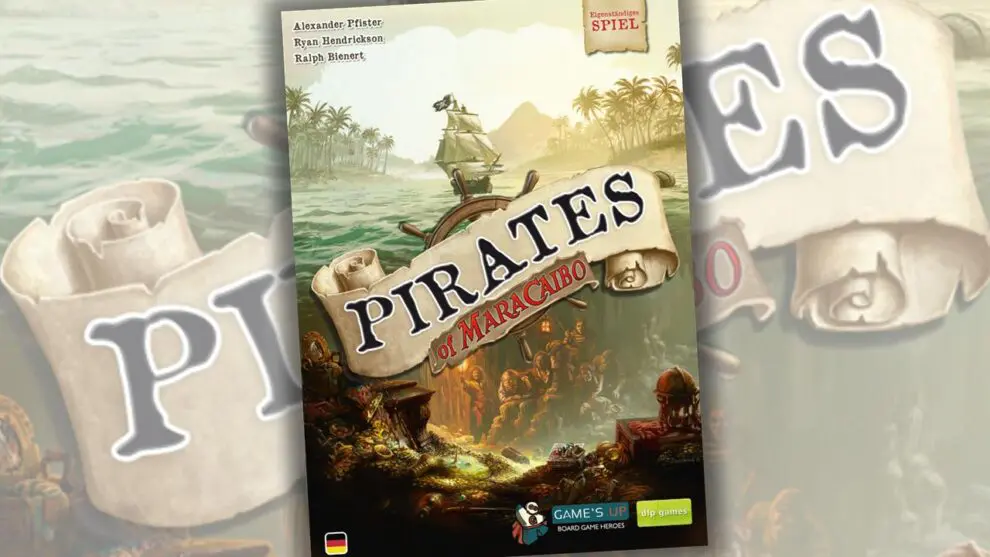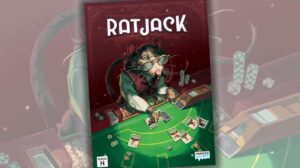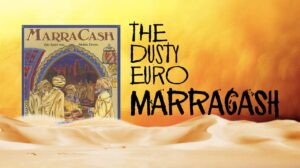Disclosure: Meeple Mountain received a free copy of this product in exchange for an honest, unbiased review. This review is not intended to be an endorsement.
About two years ago, I stared at the copy of Maracaibo (2019, Capstone Games) sitting on my shelf.
The game looked back at me. “You keep looking at me like you love me, but we used to spend so much more time together.”
“You’re right,” I said. “The problem isn’t totally on you, and I don’t think the problem is me, either. The problem is that as much as I love you, you take a while to set up, you take a while to teach, and every time I have to explain how combat works and where cubes go on the map and how all that affects the end-game scoring mechanics, I pivot to another game. Plus, all that usually takes two, maybe three hours, to play…I just think it’s best that I find another home for you.”
With that, I gifted Maracaibo to a guy in my review crew. I got the Maracaibo app (which, sadly, still doesn’t support play against AI opponents outside of the solo game) then basically stopped playing the game until it appeared on Board Game Arena a few months ago.
But recently, something at the Bell household changed.
Near the end of my time at Gen Con 2024, I stopped by the Capstone booth to chat with the team about the show, and they offered a copy of Pirates of Maracaibo, the standalone version of the game that earned rave reviews at SPIEL last year. I was curious, so I accepted the copy and got it in front of my other Maracaibo junkie friends a few weeks later.
15 minutes into my first play, I breathed a huge sigh of relief. I had Maracaibo back in my arms, in a way that I never did before…because Pirates of Maracaibo is Maracaibo, with all the cardplay I love, in a package that plays in about an hour even with three players. Because set up and teardown is so simple, Pirates of Maracaibo has a significantly higher chance of getting to the table than its big brother did.
It’s a match made in heaven. If you enjoyed the base game, buy Pirates of Maracaibo. And even if you didn’t love Maracaibo the first time around, I think Pirates of Maracaibo is still worth a look.
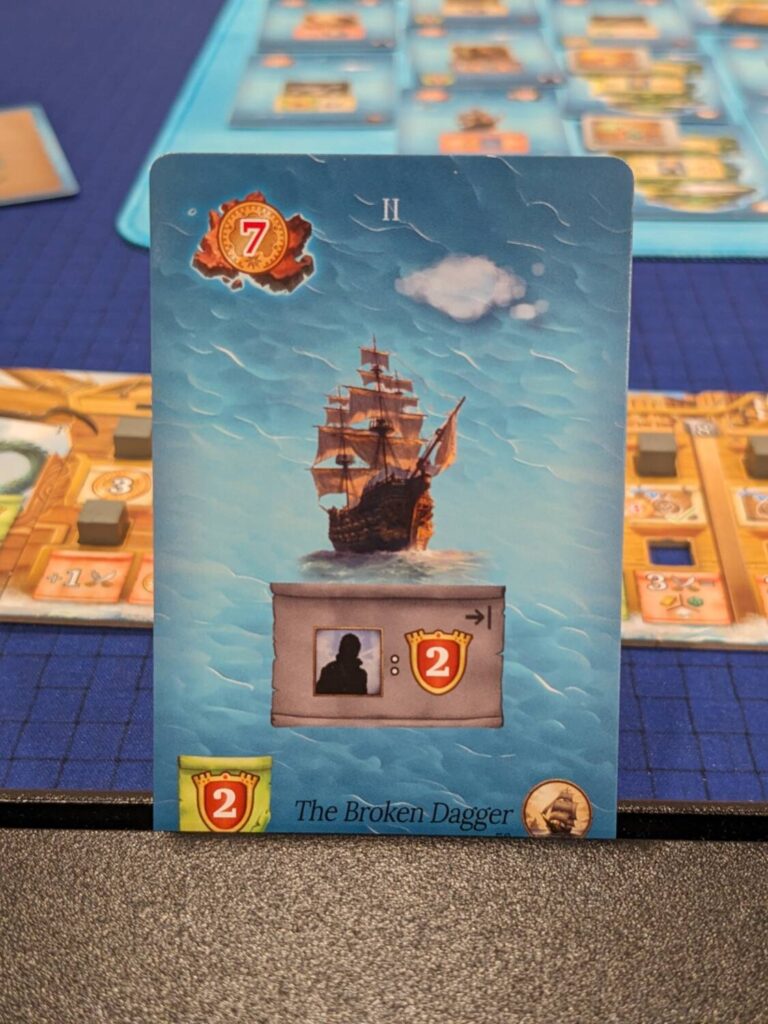
The Sea is an Ocean (of Cards)
Pirates of Maracaibo is a standalone 1-4 player exploration and treasure hunting game with many of the same tableau-building mechanics featured in the Maracaibo base game. Pirates of Maracaibo does not require a copy of Maracaibo to play, but it is certainly easier to teach if you already know how to play the original.
Although Maracaibo had a quest mechanic and a combat process, I always thought of it as a card game. I loved choosing which cards to buy, I loved buying cards that let me have special actions in certain locations, and I loved the card tagging that allowed me to burn cards to drop off goods in certain locations on the map. I was always torn about the base game’s structure of how players could speed up the end of rounds by zipping around the map and triggering the end-of-round scoring, but across four rounds I always felt I had a fair shot at scoring enough points to win.
Pirates of Maracaibo seems to know exactly what I wanted most from the base game, then delivers it in such a speedy way. Pirates of Maracaibo is even more of a card game than the base game, thanks to the removal of a standardized game board and replacing it with…you guessed it, more cards.
Pirates of Maracaibo features a map of cards split into nine columns with 2-4 cards per column. Starting from the western end of this tableau, players navigate their pirate ship by moving 1-3 spaces (cards) eastward to take actions. These cards range from Location cards, where players can upgrade their ship board and take raiding or exploration actions, to Improvement cards, which provide one-time actions or red-bannered ongoing ability upgrades. Like the base game, Improvement cards cost doubloons and that cost can be discounted by powers from other cards or ship upgrades. Residence cards, like the base game, are featured in Pirates of Maracaibo as well, now situated as places on the map that can be visited and seeded with a player’s tokens to be scored at the end of the game.
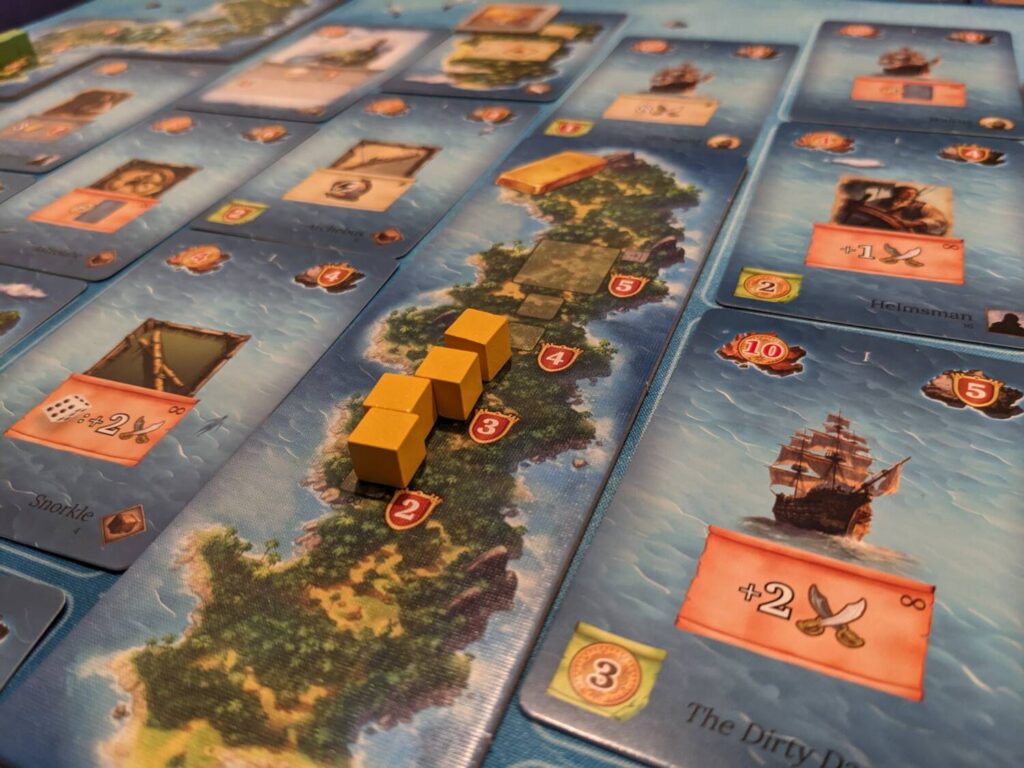
The cards are still great in Pirates of Maracaibo and it’s fun to see how the map changes. That’s because when a player buys an Improvement, it moves to the new owner’s personal tableau and is then replaced by a card from a fancier deck, so there are always a series of cards available to buy but the ways options change add a nice dynamic to decision-making.
Location cards feature a variety of options, including the Explorer mechanic from the base game. In the base game, I always felt like the Explorer mechanic required a dedicated effort to make it successful, and I rarely saw the player who did best there win the game. In Pirates of Maracaibo, the Explorer process is bundled into the core gameplay in a way that is meaningful but does not require a player to throw the majority of their energy in that direction.
The new game features a small Exploration board that takes on the same look as the original game, but now the loop is a circle where players move their Explorer meeple across rivers to gain bonuses like the ones featured in the base game (points, coins, treasure, etc.). Some of the Location and Improvement cards offer chances to move a lot of spaces at once, boosted by upgrades earned through other cards or the ship board.
There are three areas in Pirates of Maracaibo that got a significant upgrade: combat, quest cards, and ship upgrades. All three supercharge the action in Pirates of Maracaibo by streamlining processes that were a chore in the original game, and all three areas prove to be upgrades over the meta that dictated play in the base game, particularly on the ship board.
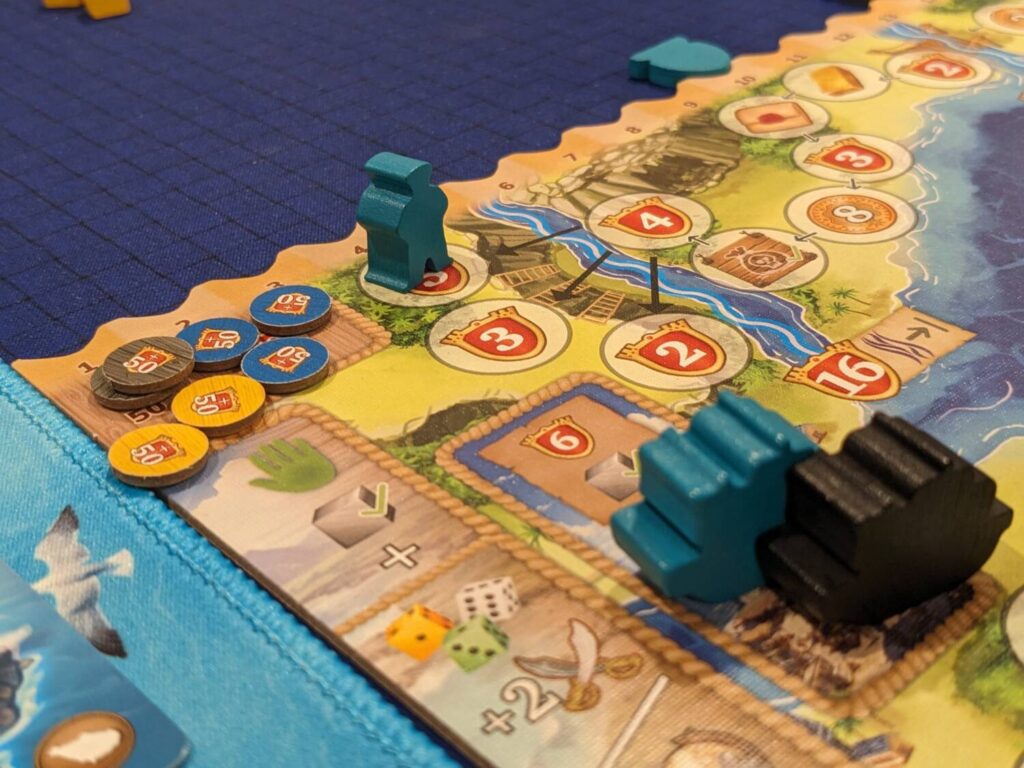
Buried Treasure
Let’s talk about the new ship board for a moment.
Remember the personal ship board from the base game? It felt like players always did the same upgrades in almost the same order every time they played: the five coins, then the one that increased hand size from four cards to six, then maybe the one that gives you three points so that you could unlock the one that gives you six more points. And, it always took two deliveries before you could earn each upgrade.
Pirates of Maracaibo knows that you don’t like to wait. So there are two major changes to the ship board. The first is that all the Location cards allow a player to upgrade their ship and get something immediately. Want three doubloons? Here you go. Another quest card? Here you go. The second change is that the ship upgrades are gated like they were in the first game, but the gates are lower.
So, after your first two upgrades, you get access to some juicier upgrade options in the second of three upgrade levels of the ship. One of my favorite options is to dump a quest card for eight doubloons. Another one rewards a player with two points if they chose to move less than they could on the Exploration map. Another upgrade lets a player buy a masthead for their ship. Mastheads, new to Pirates of Maracaibo, give players a choice of slight asymmetry as they get one-time or ongoing powers that change the way they can play.
The ship board in Pirates of Maracaibo blows the old game’s version out of the water. I’m not sure I can even play base Maracaibo now that I’ve seen this new version. It is dope, and it is not debatable.
So, the ship board is the first, and probably best, upgrade over the base game beyond the overall playtime.

The second upgrade is the combat. In Pirates of Maracaibo, the tiles that tell players how much extra fighting power they have against each of the three factions (Spain, France, England) are gone. Now, combat is “raiding”, and raiding is cake. Three dice in three different colors are rolled. The dice represent both pips of strength that can be used to take unique combat actions as well as the flavor of treasure that can be raided with enough strength. The yellow die is gold, the green die is emeralds, and the white die is pearls. Roll the dice, then optionally reroll any number of those dice once. Your combat strength is the number of pips on one die, plus any bonuses you’ve unlocked through cards and ship upgrades.
Treasure matching the die selected (assuming a combat strength of at least five) is taken from a treasure island and placed on that player’s “Hideout Board.” In a cute nod to every pirate story ever written, newly-secured treasure is placed on the beach space of each treasure type column, but can later be “buried” into spaces below the beach line to score additional points at the end of the game. (Because I’m a nerd, I forced players to make a shoveling sound each time they took the bury treasure action.)
Raiding is fun. Better than that, raiding is easy and very fast. The one reroll option is perfect, and after that, dice mitigation options are plentiful in Pirates of Maracaibo for players who want to invest in this area. A treasure market is managed by all players and shows the current value of each treasure, so end-game scoring of each type is quite simple.
The third upgrade over the base game is quest cards. Frankly, I hated the quest mechanic in Maracaibo simply because it felt like every time I wanted to stop at a quest space, the current quest would have two tags that I didn’t have in my hand. Worse, the quests would change from time to time and an opponent would snake my ability to stop somewhere and use the tags I did have in my hand. It was hard to count on quests working out, and sometimes my Career card choice forced me into a game full of trying to make quests a thing. Meh.
Pirates of Maracaibo fixes this by allowing players to draft a quest card from a selection of two during setup, then making it very easy to get more of them during the game. The quests are straightforward and, like the base game, multistage, so a player could score three points for getting two pearl treasures buried or more points for burying three. Great, I can drive towards that right now. There are always two cards available in a quest card market, and players can always top-deck more quests if they don’t like the offer. There’s even a 10-point bonus waiting for a player if they can draft and score six or more quest cards by the end of the game.
Oh my goodness, the quest cards. None of the cards individually are that interesting, but finding ways to synergize your play to the cards is a fun puzzle. Plus, it is a major upgrade over the quest mechanic of the base game.

“I’ve Heard Enough. Tell Me Where to Sign”
Pirates of Maracaibo is the final stake in the Maracaibo base game coffin. And as strong as Alexander Pfister’s resume is, Pirates of Maracaibo might now stand as my favorite Pfister design. (We are talking about a roster of games that includes Great Western Trail, Maracaibo, Mombasa/Skymines, and Oh My Goods!.)
Pirates of Maracaibo is Maracaibo, but faster. It’s got all the same card play, with a market that has to be visited in order to be bought. It has a better combat process. It has a three-round format that might play out in a 12-14-turn sprint. The mastheads are an interesting take on player powers. The quests boost scoring. End-of-round cleanup has been turned into a points and doubloon income phase. Setup and teardown are quick.
And, the ship board is strictly better in the new version of the game.
Co-designers Ryan Hendrickson and Ralph Bienert worked with Pfister on Pirates of Maracaibo. While I don’t know Bienert’s other work, I do know Hendrickson from his work as a co-designer of Joan of Arc: Orléans Draw & Write, a game that somehow distilled Orléans into a very snappy 45-minute version of the same game. Hendrickson’s work streamlining a classic into the draw/roll/flip-and-write genre tells me that he has a good handle on ensuring an original game’s core mechanics remain intact.

My chief complaints from Pirates of Maracaibo are minimal. Many of the new icons here created questions from the experienced Maracaibo players, particularly around treasure, adding cubes to a treasure market versus adding treasure cubes to a Hideout board, and the icon for adding “Black Market Tiles” to the ocean map of cards. Speaking of those new tiles, I’m still not sure the game even needed the Black Market mechanic; it added something to each game, but it’s not the reason I would push to play Pirates of Maracaibo in the first place.
These tiles add to a minor sense of “point salad”-style scoring in this game; our scores fit into the 125-175 point range, and sometimes it did feel like I was getting points just for turning left instead of right on the ocean map to grab more treasure. You’re going to score at least a little for everything in Pirates of Maracaibo and I was surprised how close games were despite players doing drastically different things.
Wins still felt earned, and these high scores did nothing to dampen the fun I was having, but it’s worth calling this out.
One note about the production—the ocean card grid. Capstone included a copy of the playmat, with spaces for the cards in each column as well as the treasure islands. I never ask for these types of extras, but now I see why they included it—the game would have been a bit of a mess to manage on a slick table. The cards are the board, so keeping them on the neoprene mat was absolutely a benefit. I wouldn’t normally recommend this, but I think it is a good idea to buy the playmat for this game.
I played the game three times for this review: solo, two players, and three players. The solo is a very breezy way to play and the automa deck is simple to manage and scales with a six-level difficulty ramp. As a person who hated the solo variant for the base game, I’m happy to report that the difficulty here is fair and can be adjusted to match a player’s skill level. I knocked out the solo game in less than 30 minutes, so it served as a great activity during my lunch hour.
Pirates of Maracaibo is a winner. Even those who have not played the base game will find a fun Euro-style experience in a very accessible package. Highly recommended!


